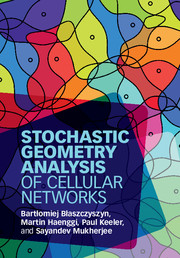Book contents
- Frontmatter
- Contents
- Preface
- Acknowledgments
- Notations
- List of Acronyms and Abbreviations
- Part I Stochastic Geometry
- 1 Introduction
- 2 The Role of Stochastic Geometry in HetNet Analysis
- 3 A Brief Course in Stochastic Geometry
- 4 Statistics of Received Power at the Typical Location
- Part II SINR Analysis
- Concluding Remarks
- Appendix A Proof of Lemma 5.3.6
- Appendix B Timeline of Cellular Technology Generations
- Appendix C Some Useful Probability Distributions
- References
- Index
2 - The Role of Stochastic Geometry in HetNet Analysis
from Part I - Stochastic Geometry
Published online by Cambridge University Press: 26 March 2018
- Frontmatter
- Contents
- Preface
- Acknowledgments
- Notations
- List of Acronyms and Abbreviations
- Part I Stochastic Geometry
- 1 Introduction
- 2 The Role of Stochastic Geometry in HetNet Analysis
- 3 A Brief Course in Stochastic Geometry
- 4 Statistics of Received Power at the Typical Location
- Part II SINR Analysis
- Concluding Remarks
- Appendix A Proof of Lemma 5.3.6
- Appendix B Timeline of Cellular Technology Generations
- Appendix C Some Useful Probability Distributions
- References
- Index
Summary
In Chapter 1, Section 1.8, we list several important and general analytical results for single-tier networks and multitier HetNets that were derived using results from stochastic geometry. Of course, the value of analytical results in yielding insights to help network design has long been recognized by the industry. Stochastic geometric approaches are only the latest, and by far the most successful, of a long line of analytical approaches that began almost immediately after the first “cellular” models for wireless communication were proposed. Before commencing a detailed study of stochastic geometry, it is useful to take a step back and examine competing analytical approaches to get a better idea of why stochastic geometric approaches achieved greater success. To do so, let us revisit the origins of the now-canonical hexagonal cell model.
The Hexagonal Cellular Concept
The earliest proposals for wireless coverage via hexagonal “cells” date back to 1947, even before the principles of information theory were published by Shannon in 1948. A more up-to-date overview of the cellular concept may be found in MacDonald's 1979 paper (MacDonald 1979), applied to what is now considered the “first-generation” or “1G” cellular standard, advanced mobile phone service. MacDonald's carefully reasoned rationale for the hexagonal cellular model bears reading even today:
He acknowledged that a practical cellular deployment would contain cells of different shapes and sizes (owing to topographic obstacles, restricted rights-ofway, etc.), but made the reasonable argument that systematization of the design and layout of a cellular system is greatly aided by modeling all cells of the system as having the same shape.
At the time MacDonald wrote his paper, cellular base stations transmitted using omnidirectional antennas. This in turn means that the boundary of the coverage region of a base station is circular. In other words, omnidirectional transmitting antennas at the base stations mean circular disk-shaped cells.
Unfortunately, circular disks do not tile (meaning, cover completely, without overlaps or gaps) the two-dimensional plane.
Three shapes that do tile the plane are equilateral triangles, squares, and (regular) hexagons.
For each of these three shapes, and with the base station located at the center of a cell with that shape, the farthest point within the cell is a vertex of that shape.
- Type
- Chapter
- Information
- Stochastic Geometry Analysis of Cellular Networks , pp. 13 - 17Publisher: Cambridge University PressPrint publication year: 2018



